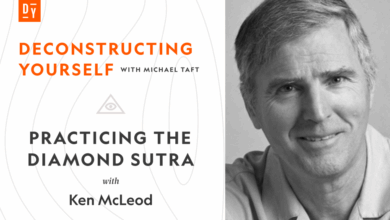Why It Feels Good but Doesn’t Stick


We’ve read the books. We’ve underlined the quotes that made an impact or turned on a lightbulb. We’ve felt the rush of possibility, the flicker of “maybe this is it…maybe this is the time it changes.” And then… back to the status quo we go.
Not because we don’t care. Not because we aren’t trying. But because the pep talk ended, the self-help or personal development book came to the end, and life continues on as always.
Dishes that need to be done, meals to prepare, obligations to meet, and a calendar brimming with things vying for our time and attention. And yet, in the background of all of that, there’s still “the thing” we want most to change or just stop. That narrative playing on a loop that makes us feel incapable, incompetent and small.
If that sounds familiar, you are not a party of one. I promise. I’m standing shoulder to shoulder with you.
You see, my love affair with self-help and personal development books began at the age of 10 when I was given my first one, “TA for Tots.” I was on a quest. A quest to figure out why I felt the way I did and thought the things I thought. While those books were helpful, I never quite got to that point of change.
That was until this beautiful “thing” called neuroscience came into view. Now, I understand that it wasn’t because I wasn’t smart enough or capable enough to leverage what I had learned in those thousands of pages I read. There was something else.
Why Pep Talks Feel Good but Don’t Always Stick
The motivation we feel from all the self-help and personal development materials we’ve consumed is real. It’s a neurochemical event. When you hear or read something inspiring, your brain releases dopamine. You feel energized, focused, maybe even clearer.
But dopamine is a spark. It’s designed to get you moving, not to keep you going. Without a structure to hold that energy, it fades. And when it fades, you’re often left with the similar reality you started with. And if you’re anything like me, it may have come with a side order of guilt for not following through.
This is where some, not all self-help and personal development content misses the mark. It offers inspiration and guidance but may not reflect how your brain works in all its unique glory.
So, for example, if your brain is already managing stress, anxiety, overwhelm, or burnout, it’s hard to process and consider any of the content they offer.
Your prefrontal cortex is the part of your brain responsible for planning, decision-making, action step development and implementation, as well as impulse control (among other things.). It helps you organize, prioritize, and initiate action.
But when you’re overwhelmed, exhausted, or emotionally flooded, that part of your brain gets quiet. And your limbic system, which manages emotion and threat detection, takes over. Suddenly, your brain isn’t asking “What’s the next step?” It’s asking, “Am I safe?”
This is why even simple tasks in a book can feel impossible.
So, when a book tells you to “just start” or “take massive action,” it may be speaking to a brain that’s dysregulated and just trying to create some semblance of safety and comfort.
Turning Helpful Content from Pep Talk to Actionable
Instead of turning what you just read or heard into another pep talk, it helps to have some ways in which to regulate your system first. What helps is taking some deep breaths. For example, you could experiment with this breathing pattern.
Take a deep breath in through your nose and fill your belly with as much air as possible. And when you think you can’t take another breath, take one more tiny “sip” of air. Hold it for 5 seconds and then exhale slowly out of your mouth. Repeat the pattern four times. This helps to signal safety to your nervous system.
When you’re feeling calm and grounded, then try experimenting with the following:
1. Choose One Insight and Anchor It
After reading or listening to something inspiring, pause. Choose one sentence. One idea. One truth that’s inspiring or that created an aha moment. Then create what we’ll call an anchor…to ground that insight and turn it into something doable.
Example: Say your insight is to start journaling every day because it will help create the clarity you’re after. The anchor could be something like, “Make it easy.”
2. Translate Insight & Anchor into a Micro-Action
Our brains love a low barrier to entry. Especially when they’re tired.
“Make it easy” becomes “Put my journal on my pillow so I write before bed.”
This isn’t about productivity. It’s about building trust with your nervous system. You’re showing your brain that change doesn’t have to hurt or take up loads of energy.
3. Build a Ritual, Not a Rule
Rules can feel rigid and constrictive. Rituals can feel much more expansive and fun. For this step, choose a sensory anchor that makes the action feel like something caring and recharging. For example…
Light a candle and play some of your favorite music. Then do that one micro action. Take a moment to notice and to celebrate what you did.
Your brain loves repetition. But it also loves meaning. Ritual gives you both.
What Happens When You Start Small
Here’s what neuroscience tells us. Small actions create momentum. They reduce cognitive load, which frees up your prefrontal cortex. And they build emotional safety, which keeps your limbic system calm.
Small actions make change feel possible. And when change feels possible, your brain kicks in gear and motivation hits the scene
This is why the “Two-Minute Rule” from Getting Things Done works. It’s not magic. It’s neuroscience. You’re lowering the activation energy required to start. And once you start, your brain builds a feedback loop of success.
But here’s the part most books miss. If you’re navigating grief, trauma, or burnout, even two minutes can feel like too much. That’s when doing something calming and taking smaller actions can make a big difference.
What to Do When You Fall Off the Wagon of Implementation
Please know this, there are going to be days when you might forget or skip. That happens.
Your brain learns through repetition, not perfection. Every time you return to the ritual you’ve created or the micro action, you strengthen the neural pathway. You’re not starting over. You’re reinforcing.
So, when you miss a day, don’t punish yourself. Just ask: What’s the smallest thing I can do right now?
Bonus Add: The Pep Talk Decoder
When you encounter a new book or podcast here’s something to experiment with. These questions can be used as filters to ensure you’re not gearing up for just another pep talk turned into…well, just another pep talk.
-
Does this speak to my current emotional bandwidth?
-
Is the advice actionable today?
-
Does it honor my brain, my life, my limits?
-
Can I build a ritual around it?
If you answered no to any of these, it might be time to just pause. To consider what, if anything, would be most helpful to do instead.
In closing…
We’ve tried. We’ve highlighted. We’ve promised ourselves this time would be different.
Maybe this time, it’s about taking the insight and allowing it to sit beside us for a while, without pressure. But instead, with the presence to know that we can take those beautiful nuggets of insight and turn them into something that’s workable and doable. Something that works with our brains and not against them.
Because sometimes, the shift doesn’t come from the pep talk. It comes from the pause that follows.
If something from this post resonated, I’d love to hear what it was.
Drop it in the comments or send me a note because your reflections matter.




